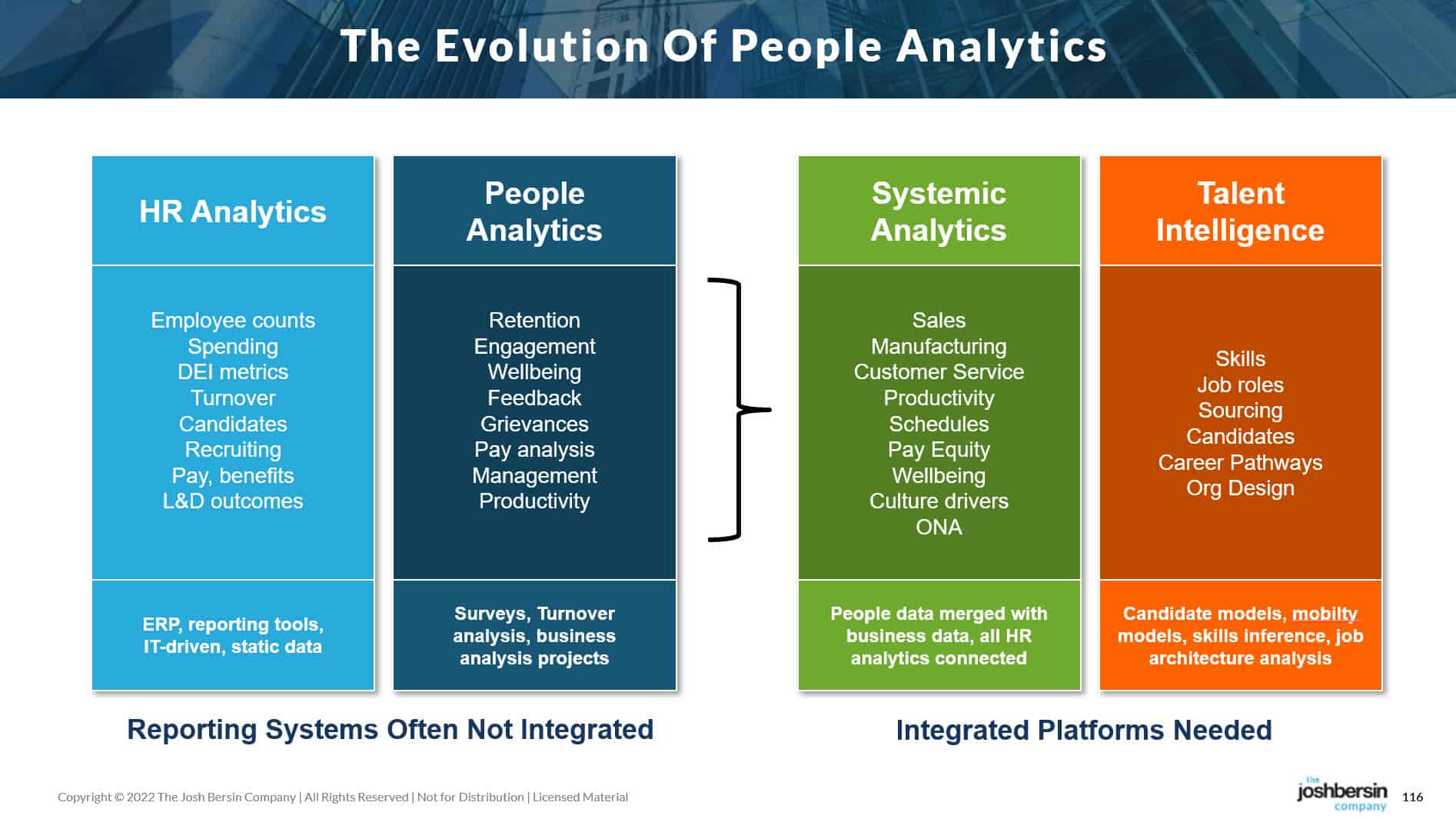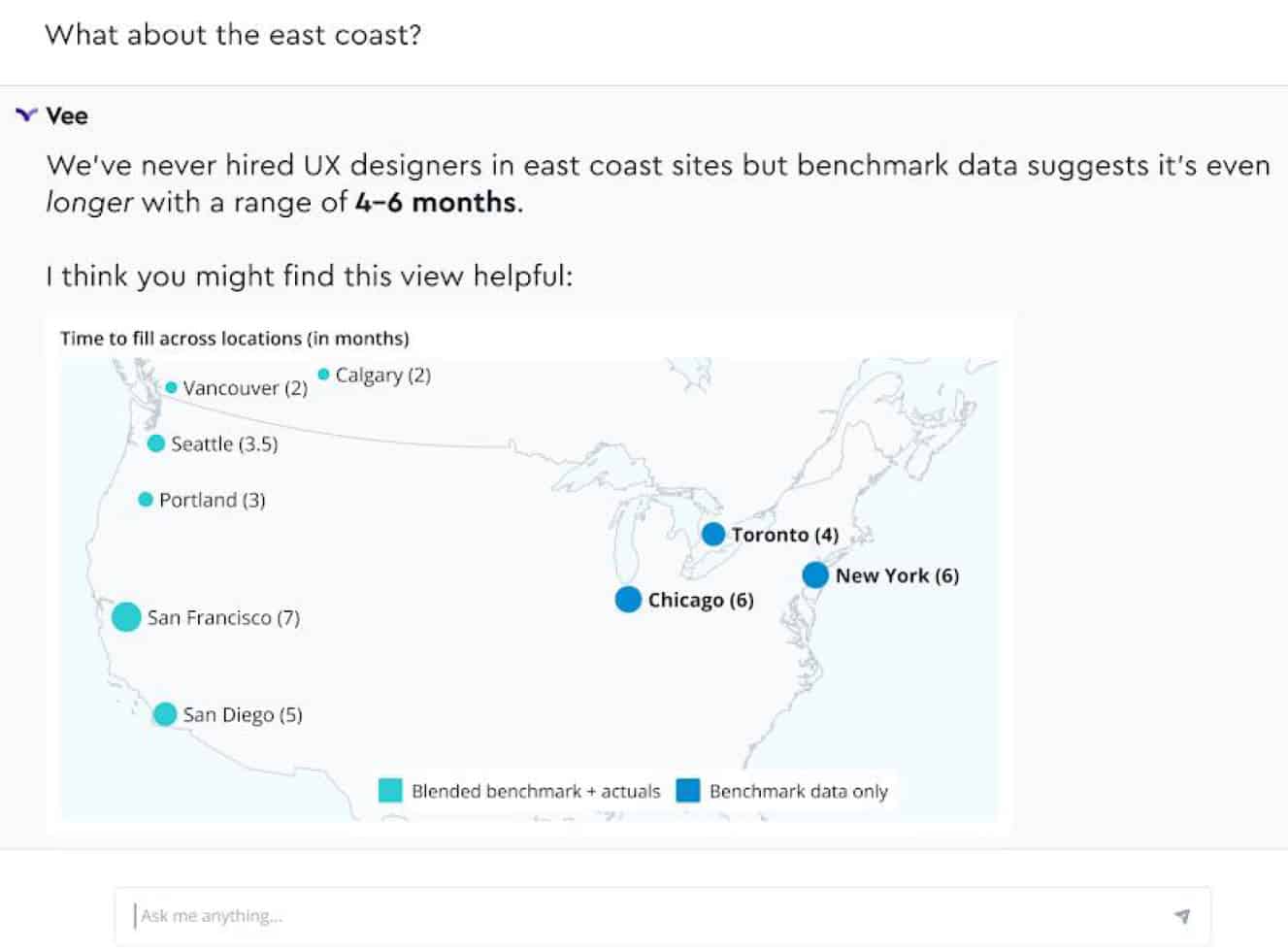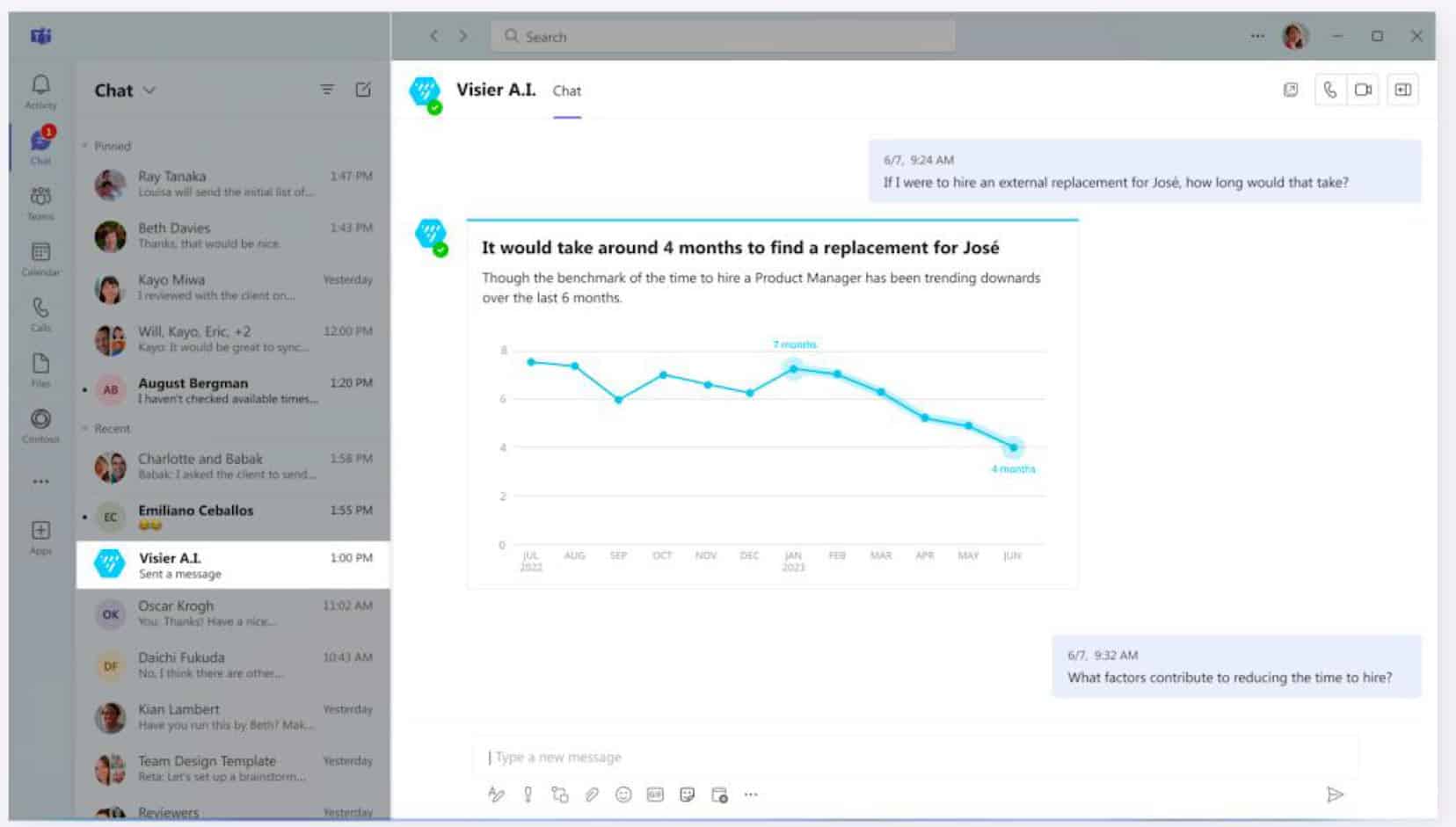People Analytics Grows Up. And Visier Introduces AI-Powered Vee.
As I discuss in this week’s podcast, People Analytics has grown up. Historically this domain was defined by engagement surveys, retention and turnover studies, and industrial and organizational psychologists. Today, thanks to a new breed of vendors (and AI), a new era has emerged. And I like to think of it as “Systemic People Analytics,” bringing together all the people data in a company to inform important business decisions.
Let me explain.
For decades companies have struggled to collect, clean, and analyze data about their people. Most organizations do a reasonable job of counting employees, measuring turnover, and keeping track of things like performance ratings, salary history, progression, and compliance training. But when you go beyond such HR measures, it’s the wild-west.
While every CHRO wants better data, companies continue to tell us they’re struggling to identify skills, find drivers of wellbeing, pinpoint factors that contribute to high performance, and develop models to assess leadership potential. Yes, we have tools and assessments that help, but when an HR business partner has to consult on an underperforming group, they struggle to get the right data.
I just listened to a podcast with Mark Zuckerberg (Meta CEO) this week and was surprised to learn that he only learned in February that the average manager at Meta had three direct reports. In his efficiency memo to employees he explains that it’s time to “delayer” the company, coining the term “flatter is faster.” Eventually these moves led to Facebook laying off almost 25% of the company. (Since then the stock has gone up by 120%: imagine if this problem had not occurred.)
My reaction is one of amazement. Despite the people analytics team in the company, they had no visibility into team size, productivity or efficiency until this year. If he and his leaders had access to this data on an ongoing basis (coupled to team performance, salary, turnover, etc.) he could have seen this coming. And companies like Salesforce and Amazon suffered the same fate.
This kind of scenario comes up all the time. A global restaurant chain told me they have no accurate count of their full-time, part-time, and franchise employees. (They are embarking on a wholesale HCM replacement just to address this issue.) One of the largest online e-commerce companies has seen a tremendous rise in turnover and cannot agree on the cause.
Last week I interviewed the CHRO of the world’s largest IT and recruiting firm and we discussed Systemic HR. I described our new model and how HR professionals need to think more holistically about problems and stop producing “single point solutions” to every challenge. She agreed and in fact they are in the process of combining the Talent Acquisition and L&D teams together with the goal of creating systemic recruiting, internal mobility, onboarding, and career programs.
Then I asked her the #1 skill she thinks their HR department needs. Her answer was “analytics.” What is the problem, I asked? It’s simple, she said, “we simply do not have integrated data to make decisions about our employees’ goals, next steps, and needs.” In her company, a pioneer in the tech space, HR business partners have to submit requests to IT to get reports, and it often takes weeks to get an answer.
This problem has to be fixed. In today’s world of talent shortages, burnout, and a proliferation of employee issues, our teams need integrated data. And as we discussed with a large group of People Analytics gurus last month, we all agreed it’s time for a new model. I like to think of it as “systemic people analytics” – bringing all the people-related data (and metadata) into one place.
 |
Think of it this way: people costs (payroll, benefits, real estate, HR) typically make up the largest discretionary expense in a company. Most companies do a better job of measuring the parts in the warehouse than they do integrating data about their people.
Why? It’s a devilishly complex problem. Systemic People Analytics means taking almost all the data we have (including employee time tracking, email traffic, organizational network data, and skills) and putting it all in one place, under an integrated metadata-centric system. This means you can find any information you need, sort and filter by any dimension, and drill up and down or go back in time to see trends.
That place, unfortunately, is not the HCM platform because it was never designed for this kind of work. It’s a new layer of software, one that’s built on multi-dimensional analysis, point and click charting, AI, and a strong metadata layer designed for HR.
And let me discuss metadata for a minute. Every company who has built an HR data warehouse (or even a big spreadsheet of HR data) figured out that “definitions of terms” or the “data dictionary” was the #1 challenge they had. Every data element about people needs a time-series view, a clear definition, and an agreement among users about what it really means. Is “turnover” the number of people who left this year? Or is it the “regrettable turnover” among people who were rated a certain rating? You get my drift.
How Can We Implement Systemic People Analytics
The People Analytics community is among the smartest, most technology savvy group in HR. They understand these problems and love to dig in and work. But they’re often given poor data platforms, a hodge-podge of HR systems to get data from, and often a lack of priority from IT. So it’s time to bring this together.
I would say you have three options, each of which has different challenges.
First, you can try to do this yourself. This is likely to take years and will include a dedicated team in IT to help. You’ll be cleaning up data, defining the data dictionary, selecting lots of tools (ETL, analytics, big data, and reporting), and then building custom dashboards and reports. And this work, which will be riddled with effort and discoveries, will likely go astray as soon as IT gets busy with something else. Plus it will be expensive.
Second, you can try to use your HCM. Yes, Workday, SuccessFactors, and Oracle have open analytics tools. But they are mostly designed for data capture and analysis, not for transformation, metadata management, end-user reporting, and non-tabular data. So these platforms are helpful, but even SuccessFactors, who bought an entire company that does this, does not have a track record of success in all its clients. So this will be an IT-driven project.
Third, you can do what I advise: go out and buy an integrated People Analytics platform. These new systems, primarily sold by Visier (by far the leader), Charthop (amazing new platform), OneModel (more of a middleware integration solution), and CruncHR (mid-market solution), are designed from the ground up to do what you need. These vendors are specialists in HR data integration from many sources, multi-dimensional analysis, and end-user reporting and analysis designed to show you everything you’re trying to find.
Most of these companies started their lives as “reporting systems” (Visier built a ground-up analytics platform from the start) but have now matured to full platforms. And among the clients we’ve talked to, the results have been absolutely astounding.
We just interviewed one of the largest manufacturers of batteries (9,000+ employees growing to 20,000 in the next five years) and their HR leader told us she was able to use Visier to show her manufacturing leaders that their overtime pay, bonus decisions, and rewards were totally inconsistent and in conflict with manufacturing productivity and quality measures. By linking the manufacturing data directly to the people data (Visier can do this out of the box), she proved to them they were mis-managing their teams.
Interestingly she also told us that prior to having this platform the managers never believed her. And this is the typical problem. If you don’t have integrated “systemic” analytics to show to business leaders they question the data, force you to go back to the drawing board, and slow down decisions. These kinds of platforms, which generate real-time analysis of almost all people-related data, can wake up business leaders to things they desperately need to know.
I know many of you have such dashboards today, and they are often used for quarterly reviews or other advisory sessions. A systemic people analytics platform does more: it gives managers (and their analysts) real-time data so they can immediately spot problems, without making analysis a “project” led by a team of PhDs. And most of these platforms have time series analysis, so you can “go back in time” and see when the problem started to occur and what precisely was likely the cause.
How Does Systemic People Analytics Collide With Talent Intelligence and AI?
How does this relate to AI and all the data in the new Talent Intelligence systems? As I describe in the podcast, today these systems are different. The big data AI systems like Eightfold, Seekout, Beamery, and Gloat are good at identifying candidates, inferring skills, and building models for performance, leadership, and more. They “learn from the data” and create unbiased models that automatically classify people into groups or pools you want to find.
People Analytics platforms do something else. They get at the core transaction data itself, and using statistics and analysis enable you to view, analyzed, and report on urgent issues as they occur. Eventually AI will enter the analytics domain (Visier is about to announce its own AI assistant which looks pretty cool), but for now these systems do different things.
Why am I making a point of this today? As we all move into Systemic HR in the future, we’re going to find that data is often our limiting factor. In order to use our 4R model for talent acquisition (Recruit, Retain, Reskill, Redesign), an HR business partner has to be able to look at candidate pipelines, turnover drivers, needed skills, internal candidates, and team productivity all at once. Without good data we are simply flying blind, leading to the situation many tech companies found themselves in when they over-hired by tens of thousands of people.
 |
Consider this: we are entering a multi-decade period when talent shortages will become epic. Not only will you be searching for rare and new skills, you’ll be worried about losing the people you have. Just as your manufacturing and marketing teams have detailed data on your beloved customers and supply chain, it’s going to be necessary to do the same for people.
Visier Introduces Vee: AI Designed For Systemic People Analytics
In the theme of this topic, today Visier introduced its own AI-powered conversational intelligence for HR, named Vee. Vee combines generative AI with the Visier People platform to let any business person simply ask questions to get systemic analytics information. Since Visier is a metadata-based multi-dimensional platform, it can answer almost any question you throw at it.
Imagine, for example, you’re a business partner working with a senior leader to hire a new team of engineers. Where should you look? Vee can answer that question:
 |
Suppose you’re considering an internal candidate for that role, and you’d like to compare the internal candidate with a possible search. Vee can help you here too.
 |
Vee integrates with MS Teams and Slack, so you have access to this kind of analytics wherever you may be. As you can imagine, this unlocks systemic people analytics to every business partner, HR advisor, and even business manager in your company.
Imagine if Mark Zuckerberg had access to this type of system before the company fell into its slow growth. Systemic Analytics platforms like Visier can help you see around corners, understand the multi-dimensional aspects to a talent challenge, and get line managers on board with new strategies.
We’ll be discussing this much more in our upcoming Systemic HR research later this year. Please contact us if you’d like help in this area.
Additional Information
Our Award-Winning Course on People Analytics (The Josh Bersin Academy)
The Talent Intelligence Primer
Redesigning HR: An Operating System, Not An Operating Model.


